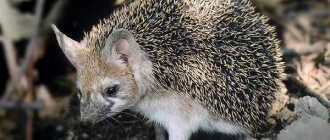Origin of the species and description
Photo: Hell Vampire
The hellvampire (Vampyroteuthis infernalis) is the only known member of the order Vampyromorphida, the seventh order of the mollusk class Cephalopoda. They combine characteristics of both octopuses (Octopoda) and squids, cuttlefish, etc. It is assumed that this may represent a ancestral line between the two groups. Hellvampires aren't technically true squids, but are so named because of their blue eyes, reddish-brown skin, and webbing between their arms.
Video: Hell Vampire
Interesting fact: The Hellvampire was discovered by the first German deep-sea expedition in 1898-1899 and is the only representative of the order Vampyromorpha, a phylogenetic transitional form to cephalopods.
In most phylogenetic studies, the hellvampire is considered an early branch of the octopiformes. In addition, it has many features that are likely adaptations to the deep sea environment. Among these latter are the loss of the ink sac and most chromatophore organs, the development of photophores, and the gelatinous consistency of tissues with a jellyfish-like consistency. The species occupies deep waters in all tropical and temperate regions of the World Ocean.
As a phylogenetic relic, it is the only known surviving member of its order. The first specimens were collected on the Valdivia expedition, and were initially incorrectly described as octopuses in 1903 by German explorer Karl Huhn. The hellvampire was later assigned a new order along with several extinct taxa.
Appearance and features
Photo: Hell Vampire Clam
The Hellvampire has eight long tentacle arms and two retractable strands that can extend well beyond the animal's overall length and can be retracted into pockets within the web. These filaments function as sensors due to the fact that the antennae cover the entire length of the tentacles with suckers on the distal half. There are also two fins on the dorsal surface of the mantle. The Hellish Vampire Squid is named for its dark black skin, membranes between its tentacles, and red eyes, all of which are characteristic of a vampire. This squid is considered small - its length reaches 28 cm. Females are larger than males.
Fun Fact: The Vampire Squid has the consistency of a jellyfish, but its most intriguing physical characteristic is that it has the largest eyes, proportional to its body, of any animal in the world.
The hellish vampire has black chromatophores with red-brown splashes. Unlike other cephalopods, these chromatophores are not functional, allowing rapid color changes. The hellvampire shares most of the other features of octopuses and decapods, but it also has several adaptations to enable it to live in deep-sea environments. Loss of most active chromatophores and the ink sac are just two examples.
The hellvampire also has photophores, which are large round organs that are located behind each adult fin and are also distributed over the surface of the mantle, funnel, head and aboral surface. These photoreceptors produce glowing clouds of glowing particles that allow this vampire squid to glow.
Nutrition
The diet of vampire squid includes:
- shells and excrement of crustaceans;
- dead plankton;
- diatoms;
- larvae;
- the smallest particles of fish bodies.
Special tentacles, called filaments, are adapted for catching pieces of deep-sea dedrite - the remains of planktonic animals. The filaments resemble sticky tape and are capable of extending beyond the main tentacles.
Yandex pictures
Little vampires collect their food using filaments and a membrane stretched between the tentacles. First, they open the membrane wide and then bring the ends of the tentacles together. A large volume of water is captured, in which nutrient particles float. The vampire squid squeezes out water through the holes between the tentacles, and detritus is held in place by filaments.
Conclusion! Thus, the vampire is not a predator, like all cephalopods, but a kind of fisherman, where detritus and other small particles act as fish.
This transition is due to the habitat of the octopus squid. At great depths, the oxygen concentration is low. Few people can adapt to such living conditions. There are no predators dangerous for vampires, but there is not much food. Collecting detritus does not take much energy. Drifting calmly in the water column, vampire squids periodically clean off nutrient particles stuck to the filaments.
Where does the hellish vampire live?
Photo: What a hellish vampire looks like
The vampire squid occupies deep spaces in all tropical and temperate waters of the oceans. This is the clearest example of a deep-sea cephalopod, which is generally believed to occupy unlit depths of 300–3000 meters, with most hellvampires occupying depths of 1500–2500 m. This region of the world's oceans contains a zone with minimal oxygen content.
Oxygen saturation here is too low to support aerobic metabolism in complex organisms. However, the hellish vampire is able to live and breathe normally with oxygen saturation of only 3%, this ability is inherent in few animals.
Interesting Fact: Observations conducted at the Monterey Bay Aquarium Research Institute showed that hellvampires are limited to the minimum oxygen layer in this bay with an average depth of 690 m and oxygen levels of 0.22 ml/L.
Vampire squids live in the oxygen-minimum layer of the ocean, where little light penetrates. The north-south distribution of the vampire squid is localized between forty degrees north and south latitudes, where the water ranges from 2 to 6 °C. Throughout its life, it is in a low-oxygen environment. Vampyroteuthis can live here because its blood contains another blood pigment (hemocyanin), which binds oxygen from water very efficiently, and the surface of the animal's gills is very large.
Now you know where the hellish vampire squid is found. Let's see what he eats.
Hero of our time
The name and appearance of the vampire squid alone is frightening and repulsive, but upon closer examination it evokes pity. This mollusk has to survive in hellish conditions of lack of food and oxygen. It does not have impressive size or creepy teeth to scare off attackers. His means of defense is a harmless lump of light and a body that tries to give itself a more intimidating appearance with the help of various tricks.
The study of the species occurs through accidental collisions of deep-sea vehicles with an animal. All that can be learned is his methods of protection and defense. Let's hope that his opportunistic methods are reliable enough to help this species survive. And we can only wish him good luck and comfortable living conditions.
What does a hellish vampire eat?
Photo: Hell Vampire Squid
Squids are carnivores. The vampire squid uses its sensory filaments to search for food in the deep sea, and also possesses a highly developed statocyst, indicating that it descends slowly and balances almost effortlessly in the water. Despite its name and reputation, Vampyroteuthis infernalis is not an aggressive predator. As it drifts, the squid unfurls one thread at a time until one of them touches a predatory animal. The squid then swims in a circle, hoping to catch its prey.
Fun fact: The vampire squid has the lowest specific metabolic rate of any cephalopod due to its reduced dependence on predators in the light-limited deep sea. He usually goes with the flow and is barely active. Large fins and membranes between the arms allow for movements reminiscent of a jellyfish.
Unlike all other cephalopods, the hell vampire does not catch living animals. It feeds on organic particles that sink to the bottom in the deep sea, called sea snow.
It consists of:
- diatoms;
- zooplankton;
- salps and eggs;
- larvae;
- body particles (detritus) of fish and crustaceans.
Food particles are sensed by two thread-like sensory arms, glued together by the suction cups of eight other arms, covered by the shell of eight holding arms, and absorbed as a mucous mass from the mouth. They have eight arms, but do not have feeding tentacles and instead use two retractable filaments to capture food. They combine waste with mucus secreted from their suckers to form food pellets.
Interesting Facts
Very little is known about deep-sea inhabitants, but we have learned some interesting and surprising facts:
- The first examples of the hellish vampire were discovered at the end of the 19th century. He is currently the only representative of the class
- The structure of a vampire octopus has the consistency of a jellyfish. Its most important physical characteristic is that its eyes, in proportion to its body, are simply huge.
- This is a very slow creature that floats with the flow and is not active. Large fins and membranes allow it to perform movements similar to those characteristic of a jellyfish.
- It is almost impossible to see this squid in aquariums. During capture, individuals often suffer serious injuries and damage, and then do not survive in aquariums.
The study of the deep-sea hell vampire is currently complicated, because little is known about the behavior of this population. We can only hope that scientists will be able to learn more about this unique representative of the underwater world.
Features of character and lifestyle
Photo: Octopus hellish vampire
The species has always been considered a slow swimmer due to its weak gelatinous body. However, it can swim surprisingly fast, using its fins to move through the water. Their highly developed statocyst, an organ responsible for balance, also contributes to their agility. It is estimated that the hellvampire reaches a speed of two body lengths per second, and accelerates to these speeds in five seconds.
The Hellvampire can glow for longer than two minutes due to photophores that either glow simultaneously or flash one to three times per second, sometimes pulsating. The organs at the tips of the hands may also glow or flash, usually accompanied by a response. The third and final form of glow is luminescent clouds, which appear as a slimy matrix with burning particles in it. The particles are thought to be released by organs in the tips of the hands or non-exposed visceral organs and can glow for up to 9.5 minutes.
Fun fact: Hellvampires are often injured during capture and can survive in aquariums for up to two months. In May 2014, the Monterey Bay Aquarium (USA) became the first to exhibit this species.
The vampire squid's primary escape response involves the glowing of the lungs at the tip of the arms and at the base of the fins. This glow is accompanied by a wave of the arms, making it very difficult to accurately determine where the squid is in the water. Next, the squid releases a slimy luminescent cloud. When the light show is over, it is almost impossible to determine whether the squid was gliding or mingling with a cloud in the bottomless waters.
Behavior and lifestyle
Representatives of this species are quite slow. This is explained by the structural features - the body of the gelatinous structure does not allow rapid movement. The creature's maximum speed is equal to two body lengths per second.
In terms of its own behavior, the vampire squid is completely harmless. It does not cause trouble to other deep-sea inhabitants and coexists peacefully with them. Despite its loud name and being a predator, the octopus does not harm anyone, although it often risks being preyed by large predatory fish.
Social structure and reproduction
Photo: Hell Vampire
Because hellvampires occupy deeper waters than large squids, they spawn in very deep waters. It is most likely that males transfer spermatophores to the female from their funnel. Female vampires are larger than males. They release fertilized eggs into the water. The matured eggs are quite large and are found floating freely in deep water.
Interesting fact: Little is known about the ontogeny of the hellish vampire. Their development passes through III and morphological forms: young animals have one pair of fins, the intermediate form has two pairs, and the mature one has one again. During their early and intermediate phases of development, a pair of fins is located near the eyes; as the animal develops, this pair gradually disappears.
As the fins grow, their surface area to volume ratio drops and they change in size and rearrange to increase the animal's efficiency in moving. Flapping the fins of mature specimens is the most effective method. This unique ontogeny has caused confusion in the past, with various forms defined as multiple species in different families.
The Hellvampire reproduces slowly with the help of a small number of eggs. Slow growth is due to the fact that nutrients are not abundant at depth. The vastness of their habitat and scattered population make family relationships random. The female may store a conical cylindrical pack containing the male's sperm for a long time before fertilizing the eggs. After that, she may have to wait up to 400 days before they hatch.
The hatchlings are about 8 mm long and are well-developed miniature versions of the adults, with some differences. Their arms lack straps, their eyes are smaller, and their threads are not fully formed. The hatchlings are transparent and survive on the generous inner yolk for an unknown period before they begin feeding actively. Small animals are often found in deeper waters feeding on detritus.
Continuation of the family line
This type of animal has been studied very little. Its population is small, and if accidentally caught and raised from the depths, it quickly dies due to a sharp pressure drop.
Reproduction occurs rarely, since meeting a female and a male in the sea is unlikely. When this happens, the male implants a set of spermatophores into the female, which she can store for a long time. After fertilization, the eggs are gestated for about 400 days. Before the mollusks are born, the female stops feeding and dies.
Natural enemies of the hellish vampire
Photo: What a hellish vampire looks like
The hellish vampire moves quickly over short distances, but is not capable of long migrations or escape. When threatened, the vampire squid makes a disorderly escape by rapidly moving its fins toward a funnel, after which a jet emerges from its mantle and zigzags through the water. The squid's defensive posture occurs when the arms and web are stretched across the head and mantle in a position known as the "pineapple pose."
This position of the arms and web makes it difficult to damage the squid due to the protection of the head and mantle, and because this position exposes heavy black pigmented areas on the animal that make it difficult to identify in the dark depths of the ocean. The glowing tips of the hands are grouped far above the animal's head, deflecting attacks away from critical areas. If a predator bites off the tip of a hellish vampire's hand, it can regenerate it.
Hellvampires have been found in the stomach contents of deep-sea fish, including:
- small-eyed grenadier (A. pectoralis);
- whales (Cetacea);
- sea lions (Otariinae).
Unlike their relatives living in more hospitable climates, deep-sea cephalopods cannot afford to waste energy on long flights. Given the low metabolic rate and low prey density at such depths, vampire squid must use innovative predator avoidance tactics to conserve energy. Their aforementioned bioluminescent "fireworks" are combined with writhing glowing arms, erratic movements and escape trajectories, making it difficult for the predator to identify a single target.
Who lives at the bottom of the ocean, or the characteristics of a hellish vampire
This mollusk lives at such depths where there is practically no oxygen. It is not warm red blood that flows in his body, but blue. Perhaps that’s why, at the beginning of the 20th century, zoologists decided that it somehow looked like evil spirits, and called the invertebrate a hellish vampire .
True, in 1903, zoologist Card Huhn classified the mollusk not as an outlandish “monster”, but as a member of the octopus family. Why the hellish vampire was called that is not difficult to guess. Its tentacles are connected by a membrane that looks like a cloak, the invertebrate is brown-red in color, and lives in the dark depths.











